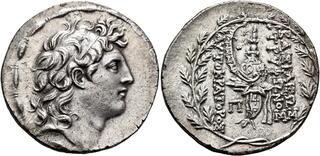| Leu Numismatik AG > Auction 15 | Auction date: 1 June 2024 |
| Lot number: 143 Price realized: This lot is for sale in an upcoming auction - Bid on this lot  | Show similar lots on CoinArchives Find similar lots in upcoming auctions on |
| Lot description: SELEUKID KINGS. Tryphon, circa 142-138 BC. Tetradrachm (Silver, 31 mm, 16.23 g, 1 h), Antiochia on the Orontes. Diademed head of Tryphon to right. Rev. BAΣIΛEΩΣ / TPYΦΩNOΣ - AYTOKPATOPOΣ Spiked Macedonian (or Cretan?) helmet with cheek guards to left, adorned with wild goat's horn above visor; in inner left field, Π; all within oak wreath. CSE -. Roma 14 (2017), 318 (same obverse die). SC -, cf. 2031 (unlisted with Π, but cf. SC 2033i for Π on a drachm). SMA -. Of the highest rarity, apparently the second known example of this variety. A beautiful coin with a magnificent portrait. The reverse struck slightly off center, otherwise, nearly extremely fine. Ex Leu 10, 24 October 2021, 2211 and previously from a German collection, formed in the 1960s. The distinctive reverse type with a helmet was minted by Tryphon in two variants, once with and once without a surrounding oak wreath (see lot 142 above). The meaning of the oak wreath is unclear - is it a victory wreath commemorating a military success, or does the significance lean more towards the divine, reminiscent of the sacred oak tree of the Zeus sanctuary in Dodona? Iconographically, Tryphon's oak wreath is certainly an innovation in Seleukid coinage. As such, it fits into a series of innovations introduced by the usurper, who could not claim dynastic Seleukid legitimacy, particularly following the death of his protégé Antiochus VI. Consequently, he ventured iconographically down new paths, introducing the new title AYTOKPATOPOΣ as well as dating his reign by regnal years instead of the Seleukid era on coins from Ake-Ptolemais. Unsurprisingly, all of these innovations were immediately abandoned following the downfall of the usurper in 138 BC. Regarding the oak wreath, it should be noted that there are several precedents for it outside the Seleukid realm, especially in the slightly earlier coinage of the Macedonian king Perseus, as well as on some nearly contemporary stephanophoric tetradrachms of Western Asia Minor, such as those from Kyzikos, Aigai, and Herakleia on the Latmos. It appears highly probable that these examples significantly influenced the iconography of Tryphon's tetradrachms from Antioch, much like the Ptolemaic prototypes did for his coinage in Ake-Ptolemais. Estimate: 5000 CHF |  |



